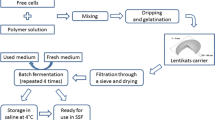Abstract
A method of protecting immobilized cells against inhibitory substances in the fermentation medium was investigated with the aim of developing a process for fermentation under unsterile conditions. It was found that yeast cells could be protected against the inhibitory effects of p-hydroxybenzoic acid esters by co-immobilizing the cells with vegetable oils. In such a system, the cells grow only in the water phase of the gel beads where most components of the fermentation medium are retained. On the other hand, the p-hydroxybenzoate that diffuses into the gel beads is retained mainly in the oil phase of the beads. Consequently, the p-hydroxybenzoate concentration in the water phase remains too low to inhibit the metabolic activities of the immobilized cells. The effectiveness of a vegetable oil in protecting the immobilized cells against an inhibitory substance depends on the partition coefficient of the substance between the oil and water, the concentration of the oil and the initial cell concentration.
Similar content being viewed by others
References
Crueger W, Crueger A (1984) Biotechnology, a text book of industrial microbiology (English edn.) Science Tech, Madison, p 86
Cysewski GR, Wilke CR (1978) Process design and economic studies of alternative fermentation methods for the production of ethanol. Biotechnol Bioeng 20:1421–1444
Grote W, Rogers PL (1985) The susceptibility to contamination of Zymomonas mobilis process for ethanol production. J Ferment Technol 63:287–290
Hahn-Hagerdal B, Mattiason B (1982) Azide sterilization of fermentation media, ethanol production from glucose using immobilized Saccharomyces cerevisiae. Eur J Appl Microbiol Biotechnol 14:140–143
Haruta M, Udagawa S, Yokoyama M eds. (1983) A new data book on control of food microorganisms (in Japanese). Science Forum, Tokyo.
Maiorella BL, Blanch HW, Wilke CR (1984) Economic evaluation of alternative ethanol fermentation processes. Biotechnol Bioeng 26:1003–1025
Manual of food additives (in Japanese) (1984) Food and Science, Tokyo
Oka S (1960) Adsorption of esters of p-hydroxybenzoic acid on yeast cells and their toxic effect. Bull Agric Chem Soc Jpn 24:412–417
Shibazaki K, Matsuda T (1957) Research on antibiotics (5). Quantitative measurement of p-hydroxybenzoate. Hakko Kogaku 35:282–287
Tanaka H, Harada S, Kurosawa H (1987) A new immobilized cell system with protection against toxic solvents. Biotechnol Bioeng 30:22–30
Tanaka H, Irie S, Ochi H (1989) A novel immobilization method for prevention of cell leakage from the gel matrix. J Ferment Bioeng 68:216–219
Author information
Authors and Affiliations
Rights and permissions
About this article
Cite this article
Tanaka, H., Ohta, T., Harada, S. et al. Development of a fermentation method using immobilized cells under unsterile conditions. 1. Protection of immobilized cells against anti-microbial substances. Appl Microbiol Biotechnol 41, 544–550 (1994). https://doi.org/10.1007/BF00178486
Received:
Revised:
Accepted:
Issue Date:
DOI: https://doi.org/10.1007/BF00178486




